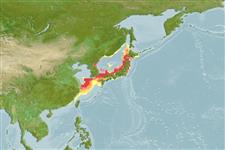Teleostei (teleosts) >
Perciformes/Cottoidei (Sculpins) >
Cottidae (Sculpins)
Etymology: Cottiusculus: Greek, kottos = a fish, diminutive.
Eponymy: Dr Petr Yulievich (Julievich) Schmidt (1872–1949) was a Soviet Russian ichthyologist who described a great many fish taxa. [...] (Ref. 128868), visit book page.
More on authors: Jordan & Starks.
Environment: milieu / climate zone / depth range / distribution range
Ecology
Marine; demersal; depth range 20 - 300 m (Ref. 56557). Temperate
Northwest Pacific: known only from off the Pacific coast of Tohoku District, Japan, Fukushima and Miyagi Prefectures.
Size / Weight / Age
Maturity: Lm ? range ? - ? cm
Max length : 10.0 cm TL male/unsexed; (Ref. 56557)
Dorsal spines (total): 6 - 8; Dorsal soft rays (total): 11 - 13; Anal soft rays: 10 - 13. This species is distinguished by the following set of characters: deeply bicuspid nasal spines; uppermost preopercular spine not barbed; elongated first dorsal fin in males; lateral line extend past caudal fin base, with 2 or 3 lateral line pores on caudal fin; no ventral lateral cirrus and lateral line cirri (Ref. 83439).
Life cycle and mating behavior
Maturity | Reproduction | Spawning | Eggs | Fecundity | Larvae
Masuda, H., K. Amaoka, C. Araga, T. Uyeno and T. Yoshino, 1984. The fishes of the Japanese Archipelago. Vol. 1. Tokai University Press, Tokyo, Japan. 437 p. (text). (Ref. 559)
IUCN Red List Status (Ref. 130435: Version 2024-2)
Threat to humans
Harmless
Human uses
Tools
Special reports
Download XML
Internet sources
Estimates based on models
Preferred temperature (Ref.
123201): 6 - 16.8, mean 14.5 °C (based on 57 cells).
Phylogenetic diversity index (Ref.
82804): PD
50 = 0.6250 [Uniqueness, from 0.5 = low to 2.0 = high].
Bayesian length-weight: a=0.00589 (0.00281 - 0.01234), b=3.15 (2.97 - 3.33), in cm total length, based on LWR estimates for this (Sub)family-body shape (Ref.
93245).
Trophic level (Ref.
69278): 3.2 ±0.40 se; based on food items.
Resilience (Ref.
120179): Medium, minimum population doubling time 1.4 - 4.4 years (Preliminary K or Fecundity.).
Fishing Vulnerability (Ref.
59153): Low vulnerability (10 of 100).
